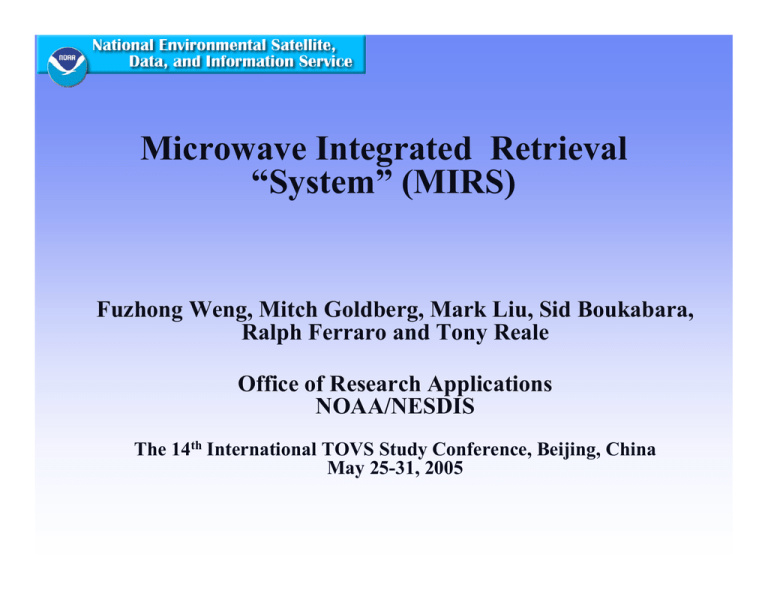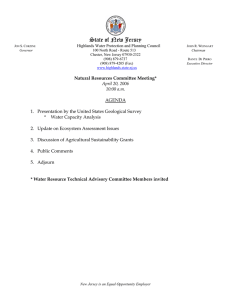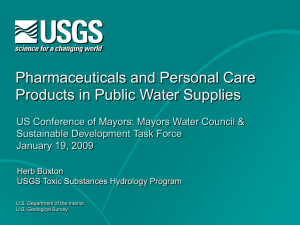Microwave Integrated Retrieval “System” (MIRS)
advertisement

Microwave Integrated Retrieval
“System” (MIRS)
Fuzhong Weng, Mitch Goldberg, Mark Liu, Sid Boukabara,
Ralph Ferraro and Tony Reale
Office of Research Applications
NOAA/NESDIS
The 14th International TOVS Study Conference, Beijing, China
May 25-31, 2005
NESDIS Plan on ATOVS System
MIRS
AMSU A/B(MHS)
ATMS
CMIS
Integrated Validation
System
INFRARED
Sounder/Imager
HIRS, AIRS, IASI, CriS,HES
AVHRR, MODIS, VIIRS,ABI
NESDIS ATOVS Plan
•
Use MIRS as front end
•
MIRS provides microwave-only retrieval, and will become an
operational product
•
MIRS microwave retrieval is first guess for HIRS. HIRS
processing software call a function which returns the required
microwave information from the MIRS.
•
HIRS information is used to derive clouds, OLR, ozone and
for clear fovs improved temperature and moisture profiles
(for temperature improvement is in lower troposphere)
AIRS, CrIS, and IASI
• Continue development of a single software
processing system for all three instrument.
• The processing
system incorporates microwave
information from AMSU and ATMS and imager
information from MODIS, VIIRS and AVHRR.
• Use of MIRS is desirable as front-end. (Microwave
algorithms are embedded within AIRS processing
system, - so software modules from MIRS will need
to be embedded)
MIRS Objectives
AMSU Cloud Liquid Water Path (3/24, 2001)
•
Enhance Microwave Surface and
Precipitation Products System (MSPPS)
Performance
•
Provide front-end retrievals for the robust
first guess to infrared sounding system
(HIRS, hyperspectral)
•
Profile temperature, water vapor and cloud
water from microwave instrument under all
weather conditions
•
Improve profiling lower troposphere by using
more “surface viewing” channels in retrieval
algorithm
•
Integrate the state-of-the-art radiative transfer
model components from JCSDA into MIRS
•
Prepare for future microwave sounding
system (e.g. ATMS, CMIS, SSMIS, GeoMW)
Weng et al. (Radio Science, 2003)
Microwave surface Emissivity at 37 GHz
Microwave Products from NPOESS CMIS
EDR Title
Atmospheric Vertical Moisture Profile (surf to 600mb)
Sea Surface Winds (Speed)
Soil Moisture
Atmospheric Vertical Moisture Profile (600 to 100mb)
Atmospheric Vertical Temperature Profile
Cloud Ice Water Path
Cloud Liquid Water
Ice Surface Temperature
Land Surface Temperature
Precipitation
Precipitable Water
Sea Ice Age and Sea Ice Edge Motion
Sea Surface Temperature
Sea Surface Winds (Direction)
Total Water Content
Cloud Base Height
Fresh Water Ice
Imagery
Pressure Profile
Snow Cover / Depth
Surface Wind Stress
Vegetation / Surface Type
Category
IA
IA
IA
IIA
IIA
IIA
IIA
IIB
IIB
IIA
IIA
IIB
IIA
IIA
IIA
IIIB
IIIB
IIIB
IIIB
III B/A
IIIB
IIIB
The highlighted are
operational EDRS
derived from POES AMSU
ER-2/DC-8 Measurements during
TOGA/CORE (1/2)
Weng and Grody (2000, JAS)
ER-2/DC-8 Measurements during
TOGA/CORE (2/2)
Clouds Modify AMSU Weighting Function
23.8
31.4
50.3
23.8
31.4
50.3
52.8
53.6
54.4
52.8
53.6
54.4
54.9
55.5
57.2
54.9
55.5
57.2
57.29+/-.217
0
0
200
200
p re s s u re (h P a )
p re s s u re ( h P a )
57.29+/-.217
400
600
800
400
cloud
600
800
1000
1000
0
0.2
0.4
0.6
weighting function
Clear condition
0.8
1
0
0.2
0.4
0.6
0.8
1
weighting function
Include two separated cloud layers at
610 and 840 hPa with 0.5 g m-3 liquid water.
Microwave Integrated Retrieval System Flowchart
•
Fast scattering/polarimetric
radiative transfer model/Jacobian
for all atmospheric conditions
•
Surface emissivity/reflectivity
models (soil, vegetation, snow/sea
ice, water)
•
Fast variational minimization
algorithm
•
NWP forecast outputs,
climatology, regressions as first
guess
•
Temperature, water vapor and
cloud and rain water profiles
•
Flexible channel selection/sensor
geometry and noise
Liu and Weng (2005, IEEE)
Algorithm Theoretical Basis (1/9)
Cost Function:
(
) (
) [
]
[
1
1
b T −1
b
o T
−1
o
J = x − x B x − x + I(x) − I (E + F) I(x) − I
2
2
where
xb is background vector
x is state vector to be retrieved
I is the radiance vector
B is the error covariance matrix of background
E is the observation error covariance matrix
F is the radiative transfer model error matrix
]
Algorithm Theoretical Basis (2/9)
• Retrievals are made at vertical pressure levels (0.1 to
•
•
•
•
•
surface, maximum levels of 42)
Surface pressure from GDAS 6-hour forecasts
Background state variables from climatology which is
latitude-dependent
First guess is from regression (could be the same as
background)
No background information needed for cloud water
Bias correction for forward models, residuals will be
observational error covariance
Algorithm Theoretical Basis (3/9)
JCSDA Community Radiative Transfer Model
Atmospheric State Vectors
Surface State Vectors
Atmospheric
Spectroscopy Model
Surface Emissivity,
Reflectivity Models
Aerosol and Cloud
Optical Model
Forward Radiative
Transfer Schemes
Receiver and Antenna
Transfer Functions
Jacobian (Adjoint) Model
Algorithm Theoretical Basis (4/9)
Radiative Transfer Model:
4π
ωF0
ω
dI(τ , Ω)
'
'
'
µ
= −I(τ , Ω) +
M
(
τ
,
Ω
,
Ω
)
I
(
τ
,
Ω
)
Ω
+
(
1
−
ω
)
B
+
exp(−τ / µ0 )S
d
∫
4π 0
4π
dτ
•
Radiative transfer scheme including four Stokes components is based on VDISORT
(Weng, JQRST, 1992)
•
Accuracies on various transfer problems including molecular scattering, L13
aerosols and microwave polarimetry are discussed (Schulz et al., JQSRT, 1999,
Weng, J. Elec&Appl., 2002 )
•
Jacobians including cloud liquid and ice water are derived using VDISORT
solutions (Weng and Liu, JAS, 2003)
•
Surface emissivity and bi-directional reflectivity models are integrated (Weng et al.,
JGR, 2001)
Algorithm Theoretical Basis (5/9)
Vector DIScrete Ordinate Radiative (VDISORT) Solution:
I l (τ ) = exp[ A l (τ − τ l −1 )] c l + s l (τ )
s l (τ ) = δ m 0 [ B (τ l −1 ) Ξ +
B (τ l ) − B (τ l −1 )
( A l−1Ξ + (τ − τ l −1 )Ξ )]
τ l − τ l −1
+ µ 0 [ µ 0 A l + E ] −1
ϖ F0
exp( −τ / µ 0 ) Ψ
π
Jacobians Including Scattering:
∂I1 ( µ )
=
∂xl
−
4N
∑
j = −4 N
L
∂ (sk (τ ) − sk −1 (τ ))
∂s1 ( µ )
K k ( µ , j ){
|τ =τ l −1 } j + δ1l
∂xl
∂xl
j = −4 N
4N
∑∑
k =l
K l ( µ , j ){
∂
exp[A l (τ − τ l −1 )]|τ =τ l c l } j
∂xl
(Weng and Liu, JAS, 2003)
Algorithm Theoretical Basis (6/9)
Emissivity Model:
Weng et al (2001, JGR)
Emissivity at V-Polarization
1.0
0.9
Snow
0.8
0.5
Canopy
Bare Soil
Wet Land
Desert
0.4
Ocean
0.7
0.6
0.3
0.2
0
20
40
60
80
100 120 140 160 180 200
Frequency (GHz)
0
Surface Emissivity Spectra (θ=53 )
1.0
Emissivity at H-Polarization
• Open water – two-scale
roughness theory
• Sea ice – Coherent
reflection
• Canopy – Four layer
clustering scattering
• Bare soil – Coherent
reflection and surface
roughness
• Snow/desert – Random
media
0
Surface Emissivity Spectra (θ=53 )
0.9
0.8
Snow
0.7
0.5
Canopy
Bare Soil
Wet Land
Desert
0.4
Ocean
0.6
0.3
0.2
0
20
40
60
80
100 120 140 160 180 200
Frequency (GHz)
Algorithm Theoretical Basis (7/9)
Snow Emissivity:
Algorithm Theoretical Basis (8/9)
Advanced Microwave Sounding Unit
•Flown on NOAA-15 (May 1998),
NOAA-16 (Sept. 2000) and
NOAA-17 (June 2002) satellites
•Contains 20 channels:
•AMSU-A
•15 channels
•23 – 89 GHz
•AMSU-B
•5 channels
•89 – 183 GHz
•4-hour temporal sampling:
•130, 730, 1030, 1330, 1930,
2230 LST
Advanced Microwave Sounding Unit
•
•
•
AMSU measurement at each
sounding channel responds
primarily to emitted
radiation within a layer,
indicated by its weighting
function
The vertical resolution of
sounding is dependent on the
number of independent
channel measurements
Lower tropospheric channels
are also affected by the
surface radiation which is
highly variable over land
Water Vapor and Cloud Water Profiles
200
0
TPW=74.56 kg/m2
TPW=73.10 kg/m2
P r e s s u r e (h P a )
P r e s s u r e (h P a )
0
400
600
retrieved
800
original
1000
0.000
0.005
0.010
0.015
200
400
600
800
1000
0.020
0.025
water vapor mixing ratio (kg/kg)
0.030
LWP=0.416 kg/m2
LWP=0.492 kg/m2
0.0000
retrieved
original
0.0002
0.0004
0.0006
0.0008
cloud water mixing ratio (kg/kg)
Standard atmosphere and cloudy layers between 800 and 950 hPa
Retrievals is based on simulated AMSU brightness temperatures at nadir
0.0010
Vertically Integrated Water Vapor
80
Match-up TPW from radiosondes
N=585, NOAA-15
bias=0.28 mm, rms=2.70 mm
TP W (m m , 1dvar)
70
and AMSU retrieval in 2002.
60
50
40
30
20
10
0
0
10
20
30
40
50
60
70
80
60
70
80
TPW (mm, radiosonde)
80
N=618, NOAA-16
bias=0.12 mm, rms=2.28 mm
70
60
50
40
30
20
60
50
40
30
20
10
10
0
0
0
10
20
30
40
N=679, NOAA-17
bias=0.07 mm, rms=2.52 mm
70
TP W (m m , 1dvar)
TP W (m m , 1dvar)
80
50
TPW (mm, radiosonde)
60
70
80
0
10
20
30
40
50
TPW (mm, radiosonde)
TPW Validation (NOAA-17)
80
80
80
40
20
0
TPW (retrived, mm
TPW (MSPPS, mm
TPW (GDAS, mm)
60
60
40
20
20
40
60
TPW (radiosonde, mm)
80
60
40
20
0
0
0
std=3.3 mm (8%)
Ocean, NOAA-17
std=4.7mm (11%)
Ocean, NOAA-17
rms=6.2 mm (15%)
Ocean
0
20
40
60
TPW (radiosonde, mm)
80
0
20
40
60
TPW (radiosonde, mm)
In comparison to radiosonde measurements, MSPPS TPW product
gives accuracy better than GDAS but is slightly biased. MIRS TPW
is the best (no priori information).
80
TPW Validation (NOAA-15)
80
80
40
20
0
TPW (retrived, mm
TPW (MSPPS, mm
TPW (GDAS, mm
60
80
std=4.8mm (12%)
Ocean, NOAA-15
std=6.1 mm (15%)
Ocean
60
40
20
20
40
60
TPW (radiosonde, mm)
80
60
40
20
0
0
0
std=3.5 mm (9%)
Ocean, NOAA-15
0
20
40
60
TPW (radiosonde, mm)
80
0
20
40
60
TPW (radiosonde, mm)
80
Retrieval Bias vs. Viewing Angles
6
Match-up TPW from radiosondes
Bias variation to viewing angles.
TPW bias (m m )
and AMSU retrieval in 2002.
NOAA-15, bias = radiosonde - retrieval
5
Bias = radiosonde – AMSU
4
3
2
1 dvar
1
MSPPS
0
-1
-2
-3
-60
-20
0
20
40
60
viewing angle (degree)
4
NOAA-16, bias=radiosonde-retrieval
3
7
NOAA-17, bias-radiosonde-retrieval
6
2
1 dvar
1
MSPPS
0
-1
-2
-60
-40
-20
0
20
viewing angle
40
60
TP W bias (m m )
TPW bias (m m )
-40
5
4
3
1 dvar
2
MSPPS
1
0
-1
-2
-60
-40
-20
0
20
viewing angle (degree)
40
60
Temperature Validation (NOAA-17)
retrieved vs radiosondes temperature
ocean, NOAA-17
Comparison of temperature to radiosondes
ocean, NOAA-17
0
200
P r e s s u r e (h P a )
P r e s s u r e (h P a )
0
retrieved, clear
400
GDAS
600
800
200
clear
400
+ cloudy
600
+ precipitation
800
1000
1000
0
1
2
standard deviation (K)
3
4
0
1
2
3
standard deviation (K)
GDAS (1 x 1 deg) and radiosondes agree well. Clouds degrade the retrieval
accuracy slightly. Clear samples = 357, clear+cloud samples = 501,
clear+cloud+precipitation=552
4
Temperature Validation (NOAA-17)
retrieved vs radiosondes temperature
ocean, NOAA-15
retrieved vs radiosondes temperature
ocean, NOAA-17
0
200
clear
400
+ cloudy
600
800
+ precipitation
P r e s s u r e (h P a )
P r e s s u r e (h P a )
0
200
clear
400
+ cloudy
600
800
+ precipitation
1000
1000
-2.0 -1.5 -1.0 -0.5 0.0
bias (K)
0.5
1.0
1.5
2.0
-2.0 -1.5 -1.0 -0.5 0.0
bias (K)
0.5
1.0
1.5
2.0
Temperature Validation (NOAA-15)
Comparison of temperature to radiosondes
ocean, NOAA-15
retrieved vs radiosondes temperature
ocean, NOAA-15
0
200
P r e s s u r e (h P a )
P r e s s u r e (h P a )
0
retrieved, clear
400
GDAS
600
800
200
clear
400
+ cloudy
600
+ precipitation
800
1000
1000
0
1
2
standard deviation (K)
3
4
0
1
2
3
standard deviation (K)
GDAS (1 x 1 deg) and radiosondes agree well. Clouds degrade the retrieval
accuracy slightly. Clear samples = 278, clear+cloud samples = 386,
clear+cloud+precipitation=416
4
Comparison of temperature to radiosonde
ocean, NOAA-15
Comparison of temperature to radiosonde
ocean, NOAA-17
0
0
P r e s s u r e (h P a )
P r e s s u r e (h P a )
Temperature Accuracy (Nadir vs. off-Nadir)
200
400
600
< 15 degree
800
> 45 degree
1000
200
400
600
< 15 degree
800
> 45 degree
1000
0
1
2
standard deviation (K)
3
4
0
1
2
standard deviation (K)
3
4
Validation for Water Vapor Profile
retrieved vs radiosondes water vapor profile
ocean, NOAA-17
retrieved vs radiosondes water vapor profile
ocean, NOAA-17
clear
+ cloudy
+ precipitation
0
10
20
30
40
50
RMS water vapor (%)
60
70
80
300
400
500
600
700
800
900
1000
clear
P r e s s u r e (h P a )
P r e s s u r e (h P a )
300
400
500
600
700
800
900
1000
+ cloudy
+ precipitation
-30
-20
-10
0
10
bias water vapor (%)
20
30
Cloud Liquid Water (MIRS vs. MSPPS)
Precipitation (MIRS vs. MSPPS)
Temperature at 850 hpa (MIRS vs. GDAS)
Temperature at 500 hpa (MIRS vs. GDAS)
Total Precipitable Water (MIRS vs. MSPPS)
Water Vapor at 500 hPa (MIRS vs. GDAS)
Water Vapor, Cloud Water and Rain Rate
TPW
CLW
Rain Rate
IWP
Impacts of Forward Models
T(850hPa) – Scattering
T(200hPa) – Scattering
T(850hPa) – Emission only
T(200hPa) – Emission only
Temperature Anomaly
With Cloud/Precipitation Scattering
Vertical cross section of temperature anomalies at 06:00 UTC 09/12/2003. Left panel: west-east cross section
along 22EN, and right panel: south-north cross section along 56EW for Hurricane Isabel
4π
dI(τ , Ω )
ω
'
'
'
µ
M
(
,
,
)
I
(
,
)
= −I(τ , Ω ) +
τ
Ω
Ω
τ
Ω
d
Ω
+ (1 − ω)St
∫
4π 0
dτ
Temperature Anomaly
Without Cloud/Precipitation Scattering
Vertical cross section of temperature anomalies at 06:00 UTC 09/12/2003. Left panel: west-east cross section
along 22EN, and right panel: south-north cross section along 56EW for Hurricane Isabel
µ
d I (τ , Ω )
= − I (τ , Ω ) + (1 − ω ) S t
dτ
Improved 3DVAR Analysis with AMSU
Without AMSU Cloudy Radiances
With AMSU Cloudy Radiances
Summary and Conclusions
•
Integrated uses of microwave imager and sounder data can significantly
improve temperature profiling in lower troposphere
•
Advanced radiative transfer models including cloud/precipitation scattering are
vital for improving profiling capability in severe weather conditions such as
hurricanes
•
MIRS with bias corrections to radiative transfer models produces improved
performance from AMSU and makes the retrieval errors less dependent on scan
angle
•
MIRS retrievals are being validated against variable independent sources.
Overall performances are very encouraging. The system is of great potentials for
NPOESS ATMS, CMIS applications
•
MIRS has a lot of room to improve and incorporate more variables in the
processing.
Open Issues
•
Refine the retrievals for better regional performance (e.g.
high terrains, deserts, snow/sea ice cover, coast conditions)
•
Bias corrections for water vapor sounding channels are
highly required. Alternatively, the retrievals will be also
tested with limb-adjusted AMSU measurements
•
Investigate non-convergent behaviors over particular regions
(scattering RT model vs. abnormal observations) in the last
retrieval process when AMSU-B water vapor sounding
channels are included
•
Test the system for SSMIS applications

